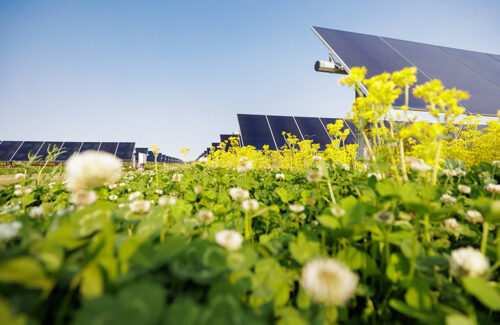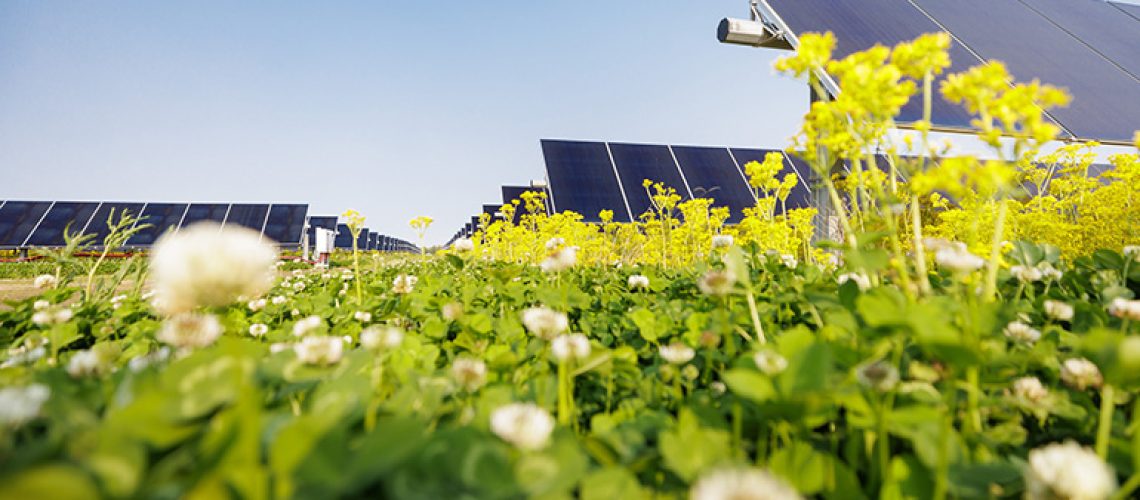The Dept. of the Interior proposed an update Thursday of its renewable energy regulations to promote the development of solar and wind energy on public lands. The Bureau of Land Management’s (BLM) proposed “Renewable Energy Rule” would reduce fees for these projects by around 80%, facilitate development in priority areas by streamlining review of applications and deliver greater certainty for the private sector, the DOI stated in a press release.
“The Department of the Interior takes seriously our responsibility to manage the nation’s public lands responsibly and with an eye toward the increasing impacts of the climate crisis. The power and potential of the clean energy future is an undeniable and critical part of that work,” said Laura Daniel-Davis, principal deputy assistant secretary for land and minerals management. “Under President Biden and Secretary Haaland’s leadership, this Administration is taking an all-hands-on-deck approach toward ambitious clean energy goals that will support families, boost local economies, and help increase climate resilience in communities across the West.”
The BLM today also published updated information regarding its ongoing environmental review for solar energy development across 11 western states.
“Our public lands are playing a critical role in the clean energy transition,” said BLM Director Tracy Stone-Manning. “This proposed rule would allow the BLM to continue leading the way on renewable energy while furthering President Biden’s commitment to building a clean energy economy, tackling the climate crisis, promoting American energy security, and creating jobs in communities across the country.”
The BLM stated that these proposed actions complement President Joe Biden’s “Investing in America” agenda, which aims to bolster U.S. infrastructure and clean energy investments.
Proposed renewable energy rule

Credit: Lightsource bp
The Energy Act of 2020 authorized the BLM to reduce acreage rents and capacity fees to promote wind and solar development on public land. The BLM initially reduced these fees through guidance in 2022. The proposed rule would codify further reductions, improving financial predictability for developers pursuing long-term projects on public land.
The proposed Renewable Energy Rule would expand the BLM’s ability to accept leasing applications in priority areas for wind and solar development without first going through a full auction. It would retain the BLM’s ability to hold competitive auctions where appropriate and consistent with past practice, and expand the BLM’s ability to accept non-competitive leasing applications when they are in the public interest.
“This update would help facilitate development in these identified priority areas while maintaining appropriate flexibility to ensure a fair return for the use of the public lands,” the press release stated.
The proposed rule opens a 60-day public comment period, which will include three public meetings. The rule changes work with the BLM’s proposed Public Land Rule, which would encourage siting projects in “appropriate” locations and prioritizing conservation on these projects. The Public Lands Rule plans to provide project developers with the tools to reduce detrimental impacts and restore the public land used for projects renewable energy projects.
“The new rules will reduce rents and fees for renewable energy projects through 2035 and eliminate duplicative payments for renewable energy developers, helping to lower overall project costs,” said Ben Norris, senior director of regulatory affairs at SEIA, in a press statement. “The rules also extend lease terms for renewable projects to 50 years, include a new category for standalone storage, and remove competitive leasing requirements in priority areas — all positive developments for the solar and storage industry.”
Since January 2021, the BLM has approved 35 renewable energy projects, including 10 solar projects, eight geothermal projects and 17 transmission projects connecting renewable facilities to the grid, on approximately 23,396 acres of BLM-managed public lands. These projects are expected to produce 8,160 MW of electricity — enough to power more than 2.6 million homes.
In addition to the proposed rule, the BLM posted preliminary alternatives to update its plans for western solar development, another step to support responsible renewable energy development on public lands. The BLM is updating its environmental review program for solar energy development across 11 Western states, building on the 2012 Western Solar Plan.
The expanded review would provide updated analysis to support identifying areas with a high potential for solar energy development and expedite permit processing and improve permit management for development in priority areas.
The BLM is currently processing 74 utility-scale onshore clean energy projects proposed on public lands in the western United States. This includes solar, wind and geothermal projects, as well as interconnected lines that are vital to clean energy development on non-federal land. These projects have the combined potential to add over 37,000 MW of renewable energy to the western electric grid. The BLM is also undertaking the preliminary review of over 150 applications for solar and wind development, as well as 51 applications for solar and wind energy testing.
The BLM manages vast stretches of public lands with the potential to contribute significantly to the nation’s renewable energy portfolio and provides sites for environmentally sound renewable energy projects.
“Efficient deployment of renewable energy on the nation’s public lands is crucial in achieving the Biden-Harris administration’s goal of a carbon pollution-free power sector by 2035, as well as Congress’ direction in the Energy Act of 2020 to permit 25 GW of solar, wind and geothermal energy on public lands by 2025,” the press release stated.
News item from the U.S. Dept. of the Interior



